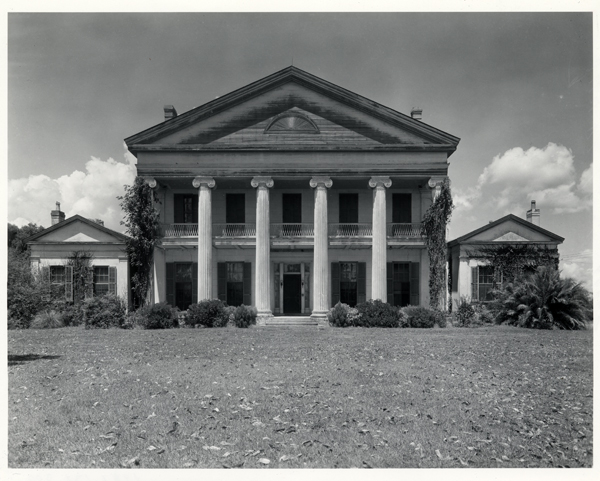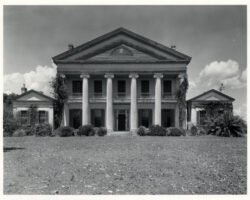Madewood Plantation
Greek Revival Madewood Plantation was one of Henry Howard's first commissions and helped launch his successful architectural practice.

Courtesy of Louisiana State Museum
Madewood Plantation. Johnston, Frances Benjamin, 1864-1952
This splendid Greek Revival house built for sugarcane planter Colonel Thomas Pugh was one of Henry Howard’s first commissions and helped launch his successful architectural practice. It was built near Napoleonville on the east bank of Bayou Lafourche, amid the sugarcane fields that made fortunes for many of the area’s planters. Bayou Lafourche was frequented at that time by steamboats from New Orleans, but the bayou’s access to the Mississippi River was eliminated in 1903 by the construction of a dam, urged by plantation owners who worried about river flooding.
Madewood is one of the finest examples in Louisiana of a Greek Revival plantation house modeled on a temple. The facade has six double-height fluted Ionic columns, on a stylobate in the Greek manner, and a pediment with a small fanlight at its center. A rear gallery is supported on boxed piers. One-story pedimented wings flank the house. The proportions are so perfectly balanced that it is no wonder Howard was much sought after by clients with exacting taste. Constructed of bricks made on the plantation by Pugh’s slaves, the house was painted white, as was then fashionable for Greek Revival designs. Interior woodwork also was milled on the plantation; this “made wood” is believed to have given the house its name. A central hall—its length and width gently interrupted by a triumphal arch on two Corinthian columns—concludes at a curved staircase. On each side of the central hall are two large rooms: a double parlor on one side and a library and bedroom on the other. The mantels in the double parlor are of cypress painted to resemble marble. A ballroom occupied space in one of the wings. Artist Cornelius Hennessey painted the cypress doors to resemble oak.
In succeeding years the house had several owners, including sugar magnate Leon Godchaux. In 1964 Naomi and Harold Marshall purchased the house and restored it. Madewood is now open to the public and offers bed-and-breakfast accommodations. The slave quarters, sugar mill, and lumber mill no longer exist. Adjacent buildings include a carriage house built in the 1840s and, relocated from nearby sites, a raised Greek Revival cottage (1822), a slave cabin, and a blacksmith’s cottage.
Adapted from Karen Kingsley’s Buildings of Louisiana, part of the Buildings of the United States series commissioned by the Society of Architectural Historians and published by Oxford University Press.
